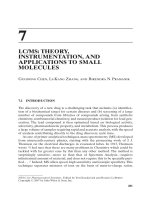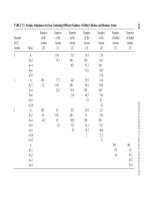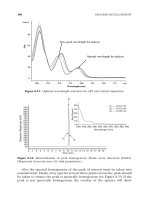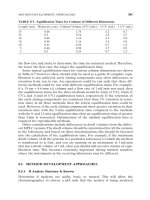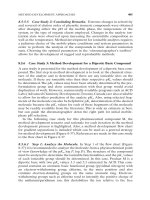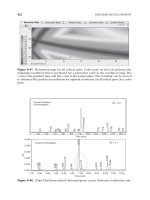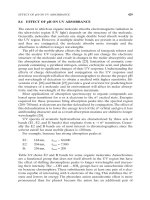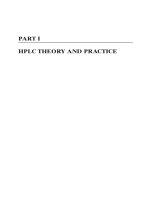Tài liệu HPLC for Pharmaceutical Scientists 2007 (Part 15) pptx
Bạn đang xem bản rút gọn của tài liệu. Xem và tải ngay bản đầy đủ của tài liệu tại đây (623.25 KB, 56 trang )
15
ROLE OF HPLC DURING
FORMULA
TION DEVELOPMENT
Tarun S. Patel and Rosario LoBrutto
15.1 INTRODUCTION
What is the definition of a formulation? Why is it needed? What is the impor-
tance of a formulation? These are some important questions that need to be
addressed during the development of a potential drug product. The strict def-
inition of the word is to specify a formula or to express a formula in system-
atic terms or concepts. The formula, in the current case, is a pharmaceutical
dosage form. A formulation is needed to deliver the drug or the active phar-
maceutical ingredient (API) to its targeted site. In order to overcome some of
the physiochemical limitations of an API, it must be combined with inert ingre-
dients (excipients) to safely and reproducibly deliver the API by the selected
route of administration. Whether the delivery of a drug is oral (capsules,
tablets, suspensions), by injection (intravenous and intramuscular injections),
transdermal (patches), or by inhalation (metered dose inhaler, dry powder
inhalation, nebulizer), the drug (active pharmaceutical ingredient) cannot be
delivered by itself.
Formulation development is a complex process involving the physiochem-
ical characterization of the API, identifying compatible excipients, developing
a reliable manufacturing process, and thorough analytical characterization of
the dosage form. The entire process starts early in the preformulation stage
(covered in Chapter 12) and continues until the final market image is devel-
oped and launched (after approval from health authorities). The goal of any
679
HPLC for Pharmaceutical Scientists, Edited by Yuri Kazakevich and Rosario LoBrutto
Copyright © 2007 by John Wiley & Sons, Inc.
formulation development is to ensure that each batch manufactured meets the
specifications for identity
, strength, quality, and purity.
Formulation development has four generic phases that are somewhat
aligned to the clinical phases: preclinical, clinical, registration, and commer-
cial. During the preclinical stage, the first dosage form is developed to evalu-
ate the safety and pharmacokinetic profile in humans. Generally due to
limitations in the availability of an API and to minimize development time,
this formulation is not optimized from a manufacturing perspective. For
oral delivery, formulations such as powder in a bottle or a capsule are often
selected.The information derived from preformulation studies is used to select
the excipients for this first formulation. Depending upon the drug, its target,
and its effect, a clinical trial may last anywhere from days to months. During
this time, clinical programs are being updated and the product moves from
one clinical phase to another (Preclinical, Phase I, Phase IIA, Phase IIB, Phase
III, and Phase IV).
Preclinical studies are initial studies that are conducted to determine poten-
tial new treatments for specific disease indications.Animal models and in vitro
assessments are used to help determine a treatment’s safety prior to intro-
ducing it to humans. Phase I clinical trials are conducted to evaluate the safety
of a drug, study absorption, and metabolism and how the drug should be
administered (e.g., injection, oral), and different dose levels may also be eval-
uated. Phase 1 trials typically involve a small group ranging from 5 to 80
patients which depends on the disease indication. Phase II clinical trials are
conducted to further evaluate the safety of a drug and to evaluate its efficacy,
and further studies are performed to determine optimal dose levels. Phase II
trials typically involve approximately 100 to 300 patients, depending on the
disease indication. They usually contain a control and treatment group. Phase
II is usually broken up into two subphases, Phase IIa (Proof of concept) and
Phase IIb (dose ranging). Phase III clinical trials are conducted to confirm the
safety and efficacy of a new drug and determine the labeling information.Trial
participants are usually included in one of two study groups such that one will
receive the new drug being evaluated, and the other group receives the already
approved, current standard of treatment. Phase III trials can enroll anywhere
from 50 to 15,000 patients.
In the early clinical phases, the safe and efficacious dose range is identified.
Often based upon this new clinical information and marketing input, a new
formulation must be developed, generally during Phase II. Before the pivotal
Phase III clinical trials, the final market image should be available.This dosage
form must be optimized, scaled-up, and validated.
During initial clinical trials, only a small number of units of dosage forms
are manufactured and put on stability. When additional and longer clinical
trials are taking place, the scale-up process of making the dosage form is
further investigated. The scale-up procedure is not a single-fold scale-up from
few units to commercial scale (millions of units) but is rather compromised of
several iterative steps. The scale-up is generally performed in stages: few units
680 ROLE OF HPLC DURING FORMULATION DEVELOPMENT
(bench scale) to thousands (lab scale) to hundred thousands (pilot scale) to
millions (validation and commercial).
During the scale-up
, many attributes of a dosage form are defined. In addi-
tion, excipients may need to be changed since the original formulation may
not be scalable. Ratios and physical attributes (appearance, color, embossing,
size, etc.) of all material within the dosage form are defined at this point. Each
time the process is scaled-up, the dosage form must be carefully characterized
to ensure that the physiochemical properties and quality attributes have not
changed.
During formulation development, these changes in the quality attributes
are monitored employing several analytical methods (identification, assay, dis-
solution rate, related substances, content uniformity, etc.). HPLC plays a vital
role in these analyses. Similar to formulation development, the health author-
ities recognize that the methods may change as one learns more about the
drug product or changes occur in the formulation during the development of
a given formulation.
15.2 PREREQUISITE FOR ANALYTICAL CHEMISTS DURING
FORMULATION DEVELOPMENT
One of the strengths that an analytical chemist in the pharmaceutical indus-
try has is the ability to propose degradation pathways without doing an exper-
iment. Based on a given API structure and the environment that the API is
going to reside in (solid state and/or solution state over time), degradation
pathways are postulated based on known organic chemistry. An exact struc-
ture of degradation product is not necessary during the paper exercise, but
impact of chemical stability must be addressed. In other words, which degra-
dation pathway is most to least likely to occur, at certain conditions, must be
discussed in order to direct formulation development from its inception.
An addendum at the end of this chapter highlights some common degra-
dation pathways, along with reactions of some common functional groups [1]
present in the literature. For an analytical chemist who works in a pharma-
ceutical research and development group, it is necessary to postulate degra-
dation products and is essential that stability-indicating methods (SIMs) for
new molecular entities (NMEs) be developed that can separate these poten-
tial degradation products from the active pharmaceutical ingredient.
15.2.1 Major Degradation Pathways in Pharmaceuticals
There are four major degradation pathways that an analytical chemists must
focus on for pharmaceutical analysis: thermolytic (heat), hydrolytic (water),
oxidative (oxygen, light, peroxide), and photolytic (UV and Vis light).
Many typical organic reactions that are potential degradation pathways are
discussed in the addendum to this chapter as they pertain to an analytical
PREREQUISITE FOR ANALYTICAL CHEMISTS 681
chemist in drug substance and drug product sectors of pharmaceutical devel-
opment.
References 2–7 provide a more in-depth analysis of the major degra-
dation pathways for pharmaceuticals.
All of the background information discussed in the addendum (Common
Functional Groups) will help an analytical chemist with development of a
stability-indicating method (SIM) that will assist in the development of an
optimized formulation that will become a drug product in the market-
place. Remember, an analytical chemist must be able to provide knowledge, not
just data.
15.3 PROPERTIES OF DRUG SUBSTANCE
By the time an active pharmaceutical ingredient (API) is made available to
an analytical chemist in the formulation development group, most or all of the
physical characteristics of an API has already been studied and the informa-
tion should be available in some sort of a report from the drug substance group
or preformulation group. Some of the key parameters that an analytical
chemist in formulation development requires from such a report are the sol-
ubility and solution stability.
15.3.1 Solubility of Drug Substance in Presence of Formulation
Many times, depending upon the active-to-excipient ratio, the solubility of
active in presence of excipients in certain solvents will be different. When an
API is mixed with excipients, its solubility is usually lower when compared to
its solubility in the same solvent by itself.
If the HPLC mode for the analysis of a given drug product is reversed-
phase HPLC (RP-HPLC), then the solubility of an ionizable API in aqueous
solutions (pH from 1.0 to 10), methanol, acetonitrile and in aqueous/organic
mixtures should be determined by an analytical chemist during formulation
development. On the other hand, if alternative modes of HPLC analysis for a
given drug product such as normal phase is employed, then the solubility of
API in IPA, and hexane, is also very important. The main reason that an
analytical chemist supporting formulation development must know the
solubility before the commencement of method development is that this
information will provide an initial assessment of the type of mobile phase
(separation or a potency method) and/or sample preparation solvent
(sample preparation procedure) that will be used for drug product method
development.
However, in both of the cases, the solubility listed on a drug substance
report will be higher, when compared to the API with excipient diluted in the
same solvent. This may not be true in all cases since it will mainly depend
on the type and the amount of excipients present in the formulation. Some
excipients may change the final pH of the solution after addition and/or some
682 ROLE OF HPLC DURING FORMULATION DEVELOPMENT
excipients will act as solubilizing agents for a given API. In both of these
cases
, an analytical chemist must know the properties of excipients in the
formulation.
For analytical sample preparation, measurement of the final pH of the
sample solution (excipients, API(s), and sample solvent mixed together) will
be helpful in the development of any analytical procedure. If an API is known
to be stable in acidic pH (pH 1–2), then an analytical chemist will try to utilize
a certain sample solvent that has a pH in the required range. However, when
a dosage form is dissolved in a sample solvent, the excipients present in the
formulation (and even the API) will change the pH of the solution. The final
pH of the solution must be measured in order to determine the optimal pH
of sample solution to achieve longest solution stability. This is particularly
important for a long sequence of injections on autosamplers for analysis, so
solutions do not need to be made daily.
15.3.2 Solution Stability
The objective is to determine the degradation products in the solution, not in
the dosage form. It is very important to determine how the active will behave
in solution. Is an API going to degrade in the solution, and to what extent?
These questions can be answered with solution stability studies.
The goal of solution stability for different tests can vary. For assay and
degradation product test, no new degradation products (over time and above
LOQ) should be formed in solution. Certain acceptance criteria (max %
increase) may be set for impurities at particular levels during the solution sta-
bility study. For assay determination (assay, CU, and dissolution), the content
of assay over time should not change more than 2.0%. Also, refer to Chapter
9, which discusses method validation.
15.4 PROPERTIES OF EXCIPIENTS
Excipients are the so-called inert ingredients contained in a pharmaceutical
dosage form. Excipients are chosen based on their compatibility with the
API and the function of a given excipient. Analytical chemist must spend as
much time studying the properties of API as to study the properties of excip-
ients. Even though the excipients are said to be inert,they are chemicals having
functional groups (refer to Table 15-1). Some of the functional groups may
react with your API to form degradation products that could not have been
foreseen by just focusing on the structure of the API.
A special consideration must be given to the effect of water on a given drug
product (or a formulation). Water presents a real problem for a formulation
when the drug substance or the excipients are sensitive or susceptible to
hydrolysis.Whether the excipients will dissolve in certain solvents or not, their
interactions with the active (in solution and solid state) are very important.
PROPERTIES OF EXCIPIENTS 683
15.5 IMPACT OF EXCIPIENTS ON DEGRADATION OF API(S)
Excipients are chemicals and they have functional groups
. The functional
group on the excipients may react with the API under certain conditions.These
conditions could be under normal storage conditions or accelerated condi-
tions. For these reasons, excipients must not be considered inert.
For RP-HPLC, if an API is interacting with any of the excipients, then the
resulting degradation product could be of a higher molecular weight than
the API. However, this does not necessarily mean that it will elute after API,
since the retention of components in RPLC is dependent on their relative
hydrophobicity and interactions with the stationary phase. If a more
hydrophobic degradation product is formed, then such a degradation product
will elute after API peak (usually true for RP-HPLC when neutral species are
involved, but may not be true when ionizable species are involved).
In the example, shown in Figure 15-1, a development compound A has
a carboxylic acid functional group (pK
a
∼4.5). Three known synthetic by-
products of the carboxylic acid active pharmaceutical ingredient were the
alcohol, ethyl ester, and an aldehyde, which are all neutral. Three degradation
products were observed in excipient compatibility stability and/or when dif-
ferent formulations were put on accelerated stability: neutral degradation
product and two acidic degradation products (A and B). Note that the drug
substance stored under similar conditions did not produce these three degra-
dation products, indicating that some excipient(s) may be inducing degrada-
tion on the API. Using RP-HPLC and performing a pH study, by varying the
mobile-phase pH, the ionogenic nature of these degradation products was
elucidated.
The retention of degradation products A and B (acidic compounds) was
dependent on the mobile-phase pH, while the retention time of the neutrals
684 ROLE OF HPLC DURING FORMULATION DEVELOPMENT
TABLE 15-1. Common Excipients and Their Functional Groups [8]
Excipient Functional Group(s) Functional Category
a
Talc ––OH Anticaking agent, glidant, tablet and
capsule diluent, and lubricant
Mg- or Ca-stearate ––COO–– Tablet and capsule lubricant
Lactose, cellulose ––O––, ––OH Diluent for dry-powder inhalers,
tablets, and capsules
PEG ––O––, ––OH Plasticizer, solvent, suppository base,
tablet and capsule lubricant
Polymethacrylates ––CO––O–– Film former, tablet binder and diluent,
sustained release polymer in right
combinations
Triethyl citrate ––CO––O––, ––OH Plasticizer
a
R. C. Rowe, P. J. Sheskey, and P. J. Weller (eds.), Handbook of Pharmaceutical Excipients, 4th
edition, 2003 [8].
(neutral degradation product) did not change (refer to Figure 15-1). The
optimal pH of the aqueous phase was chosen to be pH 6.5 to avoid any sig-
nificant changes in retention with minor variations in the pH of the aqueous
portion of the mobile phase
. Using this pH, the API elutes prior to all the
neutral species (ethyl ester, alcohol, aldehyde, and the neutral degradation
product). The neutral degradation product eluted prior to the aldehyde peak
at all pH conditions, which indicated that this peak is less hydrophobic than
the aldehyde and is a neutral compound (varying mobile-phase pH did not
change its retention time; refer to Figure 15-1). This degradation product was
later identified by LC-MS as a cyclic product. The two known neutral degra-
dation products (alcohol and aldehyde) have lower molecular weight than the
active, but both of them still elute after the active peak. The main reason is
the retention in HPLC is dependent on the hydrophobic nature of the com-
pound and not the molecular weight. However, all three neutral species elute
in the order of their hydrophobicity (alcohol elutes first, then the aldehyde
and then the ethyl ester, Figure 15-1). The acidic degradation products, A and
B, show the greatest retention at low pH (analyzed in their predominately
neutral form) and the least retention at high pH (analyzed in their predomi-
nately ionized form), which is typical retention behavior for acidic compounds
in RP-HPLC.
Another example in which the excipient reacts with the API is the reaction
between lactose and fluoxetine hydrochloride (refer to Figure A15-6 in the
Addendum of this chapter). This is a typical example of the Maillard reaction
[9]. Another example of the Maillard reaction is presented where Prozac
(fluoxetine hydrochloride) and two generic drug products of Prozac were
compared at accelerated conditions (40°C/75% RH), and the amount of
degradation products (analyzed by HPLC) were found to be very different
between the studied formulations (refer to Table 15-2) [10]. The authors
IMPACT OF EXCIPIENTS ON DEGRADATION OF API(S) 685
Figure 15-1. Dependence of retention volume on pH of an aqueous mobile phase in
RP-HPLC for drug product A on a 150 × 3.0-mm column using a 0.7-mL/min flow rate.
indicated that the difference in amounts of degradation products is not due to
different dosage form (capsule or the tablet),
but rather due to the type and
the amount of excipients used in the formulation (in particular lactose). It is
also interesting to note that the formulation containing starch instead of
lactose gave the lowest amount of degradation products. One of the lessons
learned here must be that if an API contains an amine functional group
(primary or a secondary), avoid lactose (or a similar carbohydrate) in the
formulation.
Also, if an API is prone to hydrolytic degradation, then the formulations in
both capsules and tablets should be investigated. Capsules are made of gelatin,
sugar, and water and contain about 10–15% moisture, and gelatin can absorb
additional moisture. If gelatin capsules are placed in areas of high humidity,
they may become malformed as they absorb moisture; and if capsules are
placed in low humidity, they may become dry and brittle and may crack. The
amount of degradation products formed could be influenced by the type of
dosage form (tablets versus capsules) and the respective storage conditions
for each of the dosage forms.
15.6 TEST METHODS FOR MOST COMMON DOSAGE FORMS IN
WHICH HPLC IS THE PRIMARY TECHNIQUE
The list below is a summary of test methods that are most likely to be required
during the testing of most common dosage forms (tablets, capsules, and solu-
tions). The list is by no means an exhaustive (since test methods to determine
moisture content, pH, sterility, particulate matter, and microbial testing are not
listed) and the selection of test methods depends on an evaluation of a dosage
form and also on the phase of drug development. For each type of test, most
common techniques utilized are listed in square brackets. As can be seen,
HPLC can be employed for all of the following test methods.
•
Batch release and stability testing
Identification [HPLC, UV, IR, NIR] (for release only)
Assay [HPLC, NIR, CE, GC]
Degradation products [HPLC, CE]
686 ROLE OF HPLC DURING FORMULATION DEVELOPMENT
TABLE 15-2. Stability of Fluoxetine HCl Products at 40°C/75% RH [10]
% Total Degradation Products by HPLC
Product Major Excipient Initial 1 month 3 months 6 months 9 months
Prozac Starch 0.17 0.19 0.21 0.23 0.23
Generic A Lactose 0.43 0.47 0.60 0.90 1.10
Generic Z Lactose 0.30 0.35 0.45 0.63 0.74
Content uniformity (not needed for parenterals and on stability) [UV,
NIR,
HPLC, CE]
Dissolution (not needed for parenterals) [UV, HPLC]
•
Cleaning verification for active [HPLC, UV, ion mobility spectrometry,
MS [11–13]]
Very sensitive and specific methods are needed
•
Process validation
Analysis of blends [HPLC, NIR]
Cores and coated tablets [HPLC, NIR]
•
Extractables/Leachables (for parenterals) [HPLC]
•
Structure determination, trouble shooting [hyphenated HPLC
techniques]
The most common HPLC test methods from the above list are selected and
thoroughly described below to ensure that the dosage form for which these
test methods are selected will meet the criteria for identity, quality, potency,
and purity for a given dosage form.
15.6.1 Assay and Related Substances
The two most fundamental issues of importance in drug therapy are safety and
efficacy. The impurities found in the bulk and dosage form may cause adverse
effects by their pharmacological–toxicological profile, which in turn deter-
mines the safety of a drug.The impurities found in a drug product may possess
unwanted pharmacological and/or toxicological effects [14]. Both the quality
and safety of a drug are said to be assured when the related substances found
in the drug product are controlled and monitored effectively. Therefore, the
most important topic (from the view of an analytical chemist) during formu-
lation development is the activities around a test method for related
substances [15–17].
The related substances found in an API could have originated during the
synthetic steps, from the original starting materials/intermediates or from
impurities from the starting materials that reacted in the downstream chem-
istry (all of these are known as synthetic by-products). When a given API is
utilized to manufacture a drug product, the degradation products found in the
drug product must be identified, characterized, and/or qualified based on ICH
guidelines [18].The most important reason for this is to have a quality product,
which is the basis of having a safe and an efficacious drug to begin with. The
relationship between synthetic by-products, degradation products, and related
substances is that related substances contain the sum of synthetic by-products
(originating from chemical synthesis which do not change with time and con-
ditions) and degradation products (increases with time and varies under dif-
ferent storage conditions). However, sometimes the synthetic by-products of
the API can also be degradation products of the drug product.
TEST METHODS FOR MOST COMMON DOSAGE FORMS 687
A test method for related substances must be able to separate all known
and unidentified components from a given drug product.
The phrase that
defines this process is called “stability-indicating.”
15.6.2 Stability-Indicating Method (SIM)
What is a “stability-indicating method” (SIM)? The answer to this question is
found in the FDA guidance document [19] as follows: “Validated quantitative
analytical methods that can detect the changes with time in the chemical, phys-
ical, or microbiological properties of the drug substance and drug product, and
that are specific so that the contents of active ingredient, degradation prod-
ucts, and other components of interest can be accurately measured without
interference.”
The above statement has lot of details in reference to “what is a SIM?” The
statement starts with method validation (refer to Chapter 9). Next, most
methods need to be specific (specificity, resolution of active from related sub-
stances, peak purity), reproducible (precision), quantitative (recovery, linear-
ity, LOD, LOQ), and able to monitor a change in chemical, physical, and/or
microbiological properties of drug products over time (refer to sections on
stability testing and mass balance).
All assay and purity methods during formulation development should start
with an identical method that has been developed and validated for the par-
ticular drug substance utilized to manufacture that drug product. The drug
substance method should have demonstrated that the API is resolved from
all potential degradation products, synthetic intermediates, and degradation
products. When possible, the same drug substance method should be used for
the drug product. This is especially helpful if the impurities (synthetic by-
product) have been qualified (based on toxicological data and appropriate
safety factor) in the drug substance.Therefore if a synthetic by-product is also
a degradation product, the proposed specification limit of that degradation
product in the drug product can be assigned. However, sometimes the same
HPLC method cannot be used for the drug product due to potential interfer-
ence of excipients and solubility of the excipients at a particular mobile-phase
pH.Then a cross-correlation of the relative retention time (RRT) of the impu-
rities in the drug substance which were qualified and the RRT of the impuri-
ties in the drug product should be determined. The use of LC-MS and/or
LC-NMR is strongly encouraged. Also, if authentic synthetic by-products of
the API are available, then elution can be confirmed using both the API and
drug product methods.
Even if the same drug substance HPLC method is used for the drug
product, forced decomposition studies must be performed again for the drug
product to confirm the resolution of potential degradation products from the
API. In addition, forced decomposition studies must also be performed for dif-
ferent dosage forms (capsule, tablet, suspension, injectable, etc.) of the same
drug substance.
688 ROLE OF HPLC DURING FORMULATION DEVELOPMENT
Different dosage forms of development compound A (capsule, tablet,
suspension,
injectable, and a combination product with aspirin) previously
described in Section 15.5 were explored. The HPLC parameters/conditions
remained very similar (only a change in the gradient composition was needed).
The chromatogram in Figure 15-2 shows the observed peaks for solid and sus-
pension dosage forms.The two extra peaks in the suspension drug product are
preservatives that have UV chromophores, but are neutral. The suspension
drug product also behaved very similar to the solid dosage form (capsule and
tablet) in terms of which degradation products were formed. However, the
amounts of each of these degradation products were found to be slightly
higher than solid dosage form at identical storage conditions. The injectable
drug product had a co-solvent, a surfactant, an anti-oxidant, and a buffer
system where the API had its highest solubility. In this liquid environment, the
API degraded in a different manner than the solid dosage forms and the sus-
pension. One of the major degradation products in the injectable eluted before
the active peak (labeled as degradation product B in Figure 15-1). Based on
its retention behavior when pH was varied (refer to Figure 15-1), it indicated
that it is also an acidic in nature.
Further in development, a combination product (capsule dosage form) of
the development compound A with aspirin was proposed. The preformulation
TEST METHODS FOR MOST COMMON DOSAGE FORMS 689
Figure 15-2. HPLC chromatogram obtained for drug product in solid and suspension
dosage forms.
studies were conducted and the challenge was the separation method for both
components (aspirin and the development compound
A). Aspirin is known to
hydrolyze in the presence of water. In addition, aspirin and its potential degra-
dation products are very hydrophilic, and they eluted very close to the void
volume at mobile-phase pH values above their pK
a
. Therefore, a dual pH
mobile-phase system was employed to retain and separate the aspirin and the
development compound A (refer to Figure 15-3). A pH 1.2 mobile phase was
first utilized at an isocratic condition to elute the aspirin and its degradation
product (salicylic acid). Once both of these peaks were eluted off the column
(after the void volume), the pH of the mobile phase was increased to pH 6.5
(identical to pH stated in the last section for development product A) to obtain
a similar known degradation profile as earlier in development for develop-
ment product A. Once the gradient for development compound A was com-
pleted, the column was re-equilibrated with initial mobile phase (pH 1.2). This
dual pH method (refer to Table 15-3) has a total run time of 45 minutes, which
for preformulation studies was acceptable. This was the preliminary HPLC
method and was further optimized during development for the combination
drug product.
690 ROLE OF HPLC DURING FORMULATION DEVELOPMENT
Figure 15-3. HPLC chromatogram obtained for DP (drug product) + aspirin combi-
nation drug product. (API = Development Compound A)
TABLE 15-3. Dual pH Method
Time (minutes) Mobile Phase A Mobile Phase B Mobile Phase C Gradient
Initial 100 0 0 Isocratic
5.0 0 70 30 Step
20.0 0 70 30 linear
35.0 0 30 70 linear
40.0 0 30 70 linear
40.1 100 0 0 linear
45.0 100 0 0 linear
Mobile phase A = 30% pH 1.2 solution + 70% acetonitrile.
Mobile phase B = 90% pH 6.5 + 10% acetonitrile.
Mobile phase C = 10% pH 6.5 + 90% acetonitrile.
15.7 FORCED DECOMPOSITION
W
hen developing stability-indicating methods, forced degradation testing is
performed to demonstrate specificity of any separation method as well as to
gain some insight into the degradation pathways. Forced degradation studies
are more severe than stress studies, which are defined in health authority
guidelines. For this particular reason, it is possible that the information gained
during forced degradation may help facilitate formulation development, man-
ufacturing processes, and packaging components in which the knowledge
gained may improve overall performance of a drug product (longer shelf life,
fewer degradation products, more robust manufacturing process, etc.), which
in turn could improve its attributes (safety and/or efficacy).
According to the available guidance [20] from the FDA, forced decompo-
sition studies are carried out for the following reasons [21]. (1) development
and validation of stability-indicating methodology,(2) determination of degra-
dation pathways of drug substances and drug products, (3) discernment of
degradation products in formulations that are related to drug substances
versus those that are related to non-drug substances (e.g., excipients), (4)
structure elucidation of degradation products, (5) determination of the intrin-
sic stability of a drug substance molecule, (6) stability in solution and solid
state, (7) involve conditions that are more severe than the accelerated condi-
tions defined in guidance documents, (8) are not part of formal stability
program, (9) include conditions that analyze thermolytic, hydrolytic, oxidative,
and photolytic degradation mechanism in the drug substance and drug
product.
The guidance on forced degradation is available, as stated above; however,
the details of the investigations are left up to the pharmaceutical researcher.
Forced decomposition testing within the pharmaceutical industry varies
tremendously; this was demonstrated by Baertschi [22], who surveyed 20 phar-
maceutical companies on the practices of forced decomposition studies.
During formulation development, forced decomposition would be the first
study that must be repeated (for the reasons stated above) in the presence of
API + excipients of the potential formulation.A drug product without the API
is utilized as a control (placebo).The potential loss of API for each stress con-
dition should be targeted at about 5–10%. If API is degraded by more than
10%, then it is possible that the degradation products may be created from
the initial degradation products. Typical forced decomposition studies include
heat (40°C, 50°C, and/or 60°C—solution and solid state), light (1200KLux
hours—solution and solid state), moisture (75% RH, open), acid (0.1N HCl),
base (0.1N NaOH), and peroxide (3% H
2
O
2
). The conditions listed above in
parentheses are not exhaustive, but rather the most common practiced condi-
tions in the pharmaceutical industry [22]. Once these studies are completed,
an analyst must be able to determine the major degradation products and their
relative retention time (compared to API) for a given HPLC method. The
HPLC method should be able to resolve all possible major degradation
FORCED DECOMPOSITION 691
products generated from the forced degradation studies (heat-, light-, water-,
acid-,
base-, and peroxide-related) from the API.
Initial solution forced decomposition experiments should be focused on
determining the time required to generate a loss of about 5–10% of API at
each forced degradation condition, and these forced degradation samples can
be used during early-phase method development. Once the duration for each
forced degradation condition is estimated, then all solution forced degrada-
tion experiments are repeated (for each condition) when the final method is
developed (specificity and selectivity), and LC-MS is usually used to propose
the structures/masses of major degradation products [23]. Based on these solu-
tion forced degradation studies, particular peaks from solid-state stability
studies can be properly assigned and attributed to a particular forced degra-
dation pathway. Figure 15-4 shows the separation of the degradation products
from the API in development product A solid dosage form. This sample was
a tablet dosage form that was stressed for a few months at 50°C/75% RH
under normal light conditions in an open Petri dish. The labeled peaks were
later identified by LC-MS as listed on the chromatogram. The peaks marked
with question marks were never observed in real-time stability studies under
intended and accelerated conditions.
Some approaches/examples for conducting forced degradation studies are
given below: For a forced degradation acid study for a particular API the API
is exposed to acidic conditions. The API (at a known concentration) is usually
prepared in the sample preparation solvent, which gives 0.1M HCl concen-
tration in the final solution. Once this solution is prepared, it is injected every
half hour or hour to determine the loss of API over time. If the API is sus-
ceptible to degradation under acidic conditions, then peak(s) of degradation
products would increase over time and the API should decrease over time
692 ROLE OF HPLC DURING FORMULATION DEVELOPMENT
Figure 15-4. Chromatogram of an overly stressed solid dosage form.
(once these peaks are separated in the chromatogram, peak purity is per-
formed using PD
A and/or mass spectrometry to determine if major degrada-
tion product(s) are co-eluting and to determine spectral homogeneity of the
main component, API). An experiment for base hydrolysis is conducted in a
fashion similar to that of the acid hydrolysis experiment. In both conditions,
if no degradation is observed, the solutions could be exposed to accelerated
temperatures (40°C or 50°C) for a certain time period (ie one day) to accel-
erate degradation. If no degradation is observed, then it can be assumed that
this compound is not prone to acid/base hydrolysis.
To study oxidative degradation, an experimental design can be set up as
follows: A pre-weighed excipient mixture, API and API plus excipients, is
placed each into separate crimped headspace vials. This process is repeated
two more times. This will result in three sets of vials (excipients, API, and API
plus excipients) to be stored at three stress conditions (headspace of air, nitro-
gen, and oxygen). To generate the nitrogen (control) and oxygen stress con-
ditions, two needles would be placed in the rubber septa: one to allow flow of
gas in and one to allow flow of gas out to fill the headspace with the desired
gas. For set one, transfer nitrogen into vials and for set two, transfer pure
oxygen into vials for a few minutes and then remove the inlet and outlet
needles. If molecular oxygen is playing a role to generate degradation prod-
ucts, then the highest oxidative degradation would be observed in the set in
which the headspace vials have pure oxygen. The next highest amount would
be in set number three, where the headspace has air (note that air contains
approximately 78% nitrogen and 21% oxygen). For set number one in which
the headspace vials have nitrogen, oxidative degradation is expected to be
minimal. If for all three sets of conditions, the three types of samples have very
similar degradation profile and amount of major degradation peaks, then it
would be safe to assess that the molecular oxygen is not causing any oxidative
degradation of excipient, API, and API + excipients. The above experiment
can be performed for solid dosage form as well as liquid dosage form, where
the gas passed through the needles must be bubbled through the liquid.
The above example would show oxidative degradation through molecular
oxygen; however, oxidative degradation can occur also through trace metal
impurities or radical initiation (peroxides residues from excipients in the pres-
ence of light) [24]. All possible experiments must be performed in order to
determine how and what is the source causing the degradation. All possible
experiments should be performed earlier in development.The other unwanted
alternative would be to discover compatibility problems later in development;
at that stage, time is money. Especially if the degradation product(s) must be
identified and/or qualified this could cause delays in the clinical program.
During the development of a liquid dosage form of development compound
C, it was observed that the solution changed color from slight yellow (initial
color due to components in the formulation) to brown. What caused the
change in color was the obvious question: From one or more of the excipients
which have slight yellow color or is it from the degradation product(s) of the
FORCED DECOMPOSITION 693
API (the impurities formed could be more conjugated in nature leading to
colored impurity).
A very small impurity, even at level of 0.05%, can result in
colored material.A simple experiment was carried out in the lab.The solution
was placed at different temperatures (5°C, 40°C, 50°C, and 60°C) in a con-
trolled heated oven in sealed ampoules. Since the dosage form is stored in
ampoules, the humidity is not a variable. If the nominal analytical concentra-
tion of the major peak in solution is injected (∼0.2mg/mL), then the response
of the degradation products is small (less than 2mV) at 254 nm UV (refer to
Figure 15-5). The solution is observed to be slight yellow at 5°C, and for the
solutions stored at higher temperatures the solutions became darker in color
as the temperature approached 60°C.Other additional information is obtained
from the stacked chromatograms shown in Figure 15-5 such that some de-
gradation products increased as the temperature was raised from 5°C to 60°C
(indicated by an asterisk). Also, additional degradation products were
observed at 60°C (indicated by “a”).The peaks labeled “a” were only observed
at 60°C and were not observed at any other temperature, which indicates that
these peaks had different rate constants from the other peaks observed from
5°C to 50°C. Later in development, the highest temperature utilized for any
temperature study was 50°C.
694 ROLE OF HPLC DURING FORMULATION DEVELOPMENT
Figure 15-5. Chromatogram obtained at 254 nm for a liquid dosage form (drug product
C) stored at different temperatures.
Since the response of the peaks was low,a greater concentration (more than
10
mg/mL) of the solution was injected into the same HPLC system to achieve
greater mass on column. This is not advisable for routine analysis because the
API may overload the column and carry-over may become an issue that
is dependendent upon the API, its ionization state, and the mobile-phase
conditions.
PDA analysis was employed for the above experiment, and a UV profile at
410nm was extracted (refer to Figure 15-6). The major peak eluted at 21
minutes. The reason for choosing UV 410nm is because yellow color absorbs
in this region of the UV light.The color of the injected solutions was as follows:
5°C was faint yellow, 40°C was slight yellow, 50°C was dark yellow, and 60°C
was brown. The color of the injected solution can be correlated to the peaks
observed at UV 410nm in Figure 15-6.The change of the color of the solution
can be attributed to one or more the peaks observed at 50°C and 60°C. The
response factors of these impurities should be taken into consideration, espe-
cially if using low wavelength detection. They may not have a significant
response factor at low wavelength and may be underestimated. For this type
of formulation, it would be recommended to store at 5°C or 25°C to prevent
degradation of the drug product.The accelerated conditions in this case would
then be 25°C or 40°C, respectively.
15.8 COMPATIBILITY OF EXCIPIENTS WITH API(S)
(TYPE AND RATIO)
When an NME is discovered in research, it is an API that would be developed
further into a drug product. However, an API alone does not go into clinical
trials, but a drug product does. This means that a formulation must be
COMPATIBILITY OF EXCIPIENTS WITH API(S) (TYPE AND RATIO) 695
Figure 15-6. Chromatograms obtained at UV 410 nm for a liquid dosage form (drug
product C) shored at different temperatures.
developed to effectively deliver that particular API. Compatibility testing of
an
API and excipients(s) is a key to accelerate drug development timelines
because an unexpected stability issue later in development may increase
development time and costs [25–27].
The drug–excipient compatibility screening model developed by Serajuddin
et al. [25] could be used to determine potential stability problems due to inter-
actions of API with excipients in solid dosage forms. Table 15-4 shows an
example of binary and ternary mixtures employed by Serajuddin et al.
The design of the experiment should be able to determine the chemical
nature of an excipient with the API, chemical stability based on the API–excip-
ient ratios, and effect of temperature, water, and light. Not all of the stated
variables are studied for a given API, since some information on the API
would be known beforehand. For example, if the molecule is light-sensitive,
all compatibility experiments would be performed in the absence of light and
then the final solid dosage form would be film-coated to avoid light degrada-
tion, or for an uncoated drug product the packaging material can be chosen
to avoid penetration of light, or the coated material inside a bottle (if a bottle
is chosen as a packaging material) could be covered by black color because
black color absorbs light.
In the following excipient compatibility example, drug substance was put
on accelerated stability with different binary ratios of varied excipients and
stored at 2 weeks and 4 weeks at dry and humid conditions, 50°C (dry) and
50°C/75% relative humidity,respectively (Figure 15-7).With most of the excip-
ients under dry conditions, it was observed that the level of increase of degra-
dation products in the binary mixtures was less than 0.2%. However, under
50°C/75%RH conditions, most of the excipients showed increasing degrada-
696 ROLE OF HPLC DURING FORMULATION DEVELOPMENT
TABLE 15-4. Example of Compatibility Experimental Design
123456
Drug substance (I) 200 25 25 25 25 25
Lactose 175 170
Mannitol 175
Microcrystalline cellulose 175
Dibasic calcium phosphate dihydrate 175
Magnesium stearate 5
Sodium stearyl fumarate
Stearic acid
Potency remaining
a
(% initial) 96.4 95.7 95.8 93.9 85.0 64.3
Hydrolysis product formed 3.3 4.1 4.0 5.8 16.7 37.0
a
Compositions of drug–excipient blends used for I and assay results after 3 weeks of storage at
50°C in closed vials with 20% added water; weights of all ingredients are in milligrams.
Source: Reprinted from reference 25, with permission.
tion at 2 weeks and further degradation at 4 weeks, indicating that if these
excipients are to be used for further formulations
, the formulation should be
protected from moisture. The major degradation product was identified by
HPLC-MS as the carboxylic acid impurity.
COMPATIBILITY OF EXCIPIENTS WITH API(S) (TYPE AND RATIO) 697
Experiment
7 8 9 10 11 12 13 14 15 16 17
25 25 25 25 25 25 25 25 25 25 25
170 170
170 170 170
170 170 170
170 170 170
555
5555
5555
65.4 65.3 68.1 77.9 81.9 77.6 81.8 90.0 92.9 88.1 78.3
36.7 36.3 33.7 21.8 15.4 20.1 15.3 9.7 6.9 11.7 21.6
Figure 15-7. Excipient compatibility screening performed in early formulation
development.
This drug substance contains an amide bond; this can be amenable to
acid/base hydrolysis
, consequently leading to a carboxylic acid degradation
product.This potential degradation product was predicted from looking at the
structure prior to method development. Consequently, an acid stressed sample
was used in the initial method development work to generate this potential
degradation product, and measures were taken to adequately retain this
potential degradation product using the proper pH of the mobile phase and
eluent conditions. Looking at the structure of the API and predicting degra-
dation products should be a common practice for chromatographers working
in a drug product environment.
15.9 MASS BALANCE
The process of adding the assay value to the degradation products to achieve
a total close to 100% of the initial value has been discussed in an ICH
guideline [20]. An evaluation should be considered for both the assay and
the degradation products, to review the adequacy of the mass balance.
Any mass balance issue encountered during formulation development can
be addressed by questioning either the recovery step of the sample prepara-
tion (assay and degradation products), adsorption on the column, or the
detection technique (relative response factors of the degradation products)
employed.
Recovery of an active or degradation product during the sample prepara-
tion is most likely due to adsorption on the undissolved excipients or capsule
shells. The following case study [28] illustrates this point very well.
15.9.1 Case Study 1
A combination dosage form was under development where Starlix
®
and Met-
formin HCl were combined together. During spiked recovery experiments, it
was discovered that the recovery of Metformin HCl in the presence of excip-
ients and Starlix
®
was low at high excipients-to-Metformin ratios (in solution)
as shown in Figure 15-8. Initially, it was thought that the sample extraction
solvent is not dissolving/extracting the Metformin HCl in solution, so the
extraction was performed with different sample solvents. Refer to Table 15-5
for results. None of the selected sample extraction solvents improved recov-
ery of Metformin HCl.What if Metformin HCl was interacting with one of the
excipients in solution? To answer this question, Metformin HCl recovery was
performed with dry-mix placebo blend that contained all excipients and by
removing one excipient at a time from the blend. Refer to Figure 15-9 for
results. Figure 15-9 shows that when croscarmellose was removed from the
dry-mix placebo blend, the recovery of Metformin HCl was increased and
complete recovery was achieved. It was concluded that Metformin HCl is
698 ROLE OF HPLC DURING FORMULATION DEVELOPMENT
MASS BALANCE 699
Figure 15-8. Percent recovery of Metformin HCl and Starlix
®
in different concentra-
tion solutions spiked with placebo
.
TABLE 15-5. Recovery of Metformin HCl with Different Sample Extraction
Solvents
Metformin
in Solution (%) Sample Extraction Solvent Recovery (%)
20 Water/acetonitrile (50:50) 91.9
20 Water/methanol (50:50) 93.9
20 Water/ACN/10mM OSAS,
a
pH 2.5 92.1
20 Water/ACN/10mM SDS
b
91.9
20 Water/ACN/10mM OSAS/phosphate, pH 6.8 92.4
20 Water/ACN/20mM OSAS/phosphate, pH 6.8 93.7
20 Water/ACN/triethylamine 93.7
a
OSAS, octane sulfonic acid sodium salt monohydrate.
b
SDS, sodium dodecyl sulfate.
Figure 15-9. Percent recovery of Metformin HCl in the presence of different placebo
blends
.
interacting with croscarmellose in solution. Figure 15-10 shows the proposed
interaction between the excipient and Metformin HCl.
Since croscarmellose
in the dosage form cannot be avoided, the sample preparation procedure must
be modified to increase the recovery of Metformin HCl in solution in the pres-
ence of croscarmellose. What if another compound with an amino functional-
ity was added in the solution which can interact with croscarmellose rather
than Metformin HCl? Few amino acids given in Figure 15-11 were evaluated
700 ROLE OF HPLC DURING FORMULATION DEVELOPMENT
Figure 15-10. Functional group interaction scheme between croscarmellose and
Metformin HCl.
Figure 15-11. Structures of four (arginine, histidine, glutamic acid, and lysine) amino
acids.
for this purpose. Based on the observed data, as well as the structure, it is very
obvious that arginine would have a greater probability of interaction with
croscarmellose (refer to F
igure 15-12). Thus, higher recoveries of Metformin
HCl are observed (refer to Figure 15-13). Finally,the recovery experiment with
and without arginine in solution was repeated at 20% and 100% Metformin
HCl in solution to confirm that arginine inhibits the interaction of Metformin
HCl with croscarmellose because arginine is believed to be competing for the
MASS BALANCE 701
Figure 15-12. Functional group interaction scheme between croscarmellose and
arginine.
Figure 15-13. Percent recovery of Metformin HCl in the presence of different amino
acids.
same functional group on the croscarmellose. Refer to Figure 15-14, which
shows that arginine does play an important role in inhibiting the interaction
of croscarmellose with Metformin HCl.
This case study shows that the excip-
ients not only play a role in solid-state chemistry but also may play a major
role in solution chemistry and can aid in sample preparation of solid dosage
forms.
15.9.2 Case Study 2
A second case study [29] highlighting the mass balance issue during formula-
tion development is summarized here. Background information gained during
the development is as follows. (1) Preformulation studies were conducted to
identify excipients that are compatible with the drug. These studies included
binary and ternary mixtures. (2) Capsule and tablet formulations were selected
based on the compatibility study results, utilizing commonly used excipients—
that is, binders, fillers, disintegrants, and lubricants. (3) A wet granulation
process was utilized for both capsule and tablet formulations. However, in the
case of tablet formulations, a direct compression process was also utilized for
some selected formulations. (4) An RP-HPLC method was developed for
analysis of drug product. The extraction medium consisted of acetonitrile and
water (40/60, v/v) and was selected to ensure high solubility, disintegration,
and extractability. (5) The analytical method was demonstrated to be accurate,
702 ROLE OF HPLC DURING FORMULATION DEVELOPMENT
Figure 15-14. Percent recovery of Metformin HCl in the presence of arginine and
without arginine at different concentrations of Metformin HCl in solution.
selective, specific, linear, and quantitative (excellent recovery of active from
LOQ level to 130% of nominal value).
T
he API under development went through preformulation and initial clin-
ical service dosage form as a capsule without significant loss of assay value
(refer to Figure 15-15) and showed good mass balance (refer to Figure 15-16)
during stability studies at the 40°C/75% RH condition. The only packaging
material studied for all dosage forms was HDPE bottles with aluminum induc-
tion seal and child-resistance cap. Based on the data presented in Figures
MASS BALANCE 703
Figure 15-15. Percent assay of drug product (different dosage strengths) over 1.5
months of storage at 40°C/75% RH condition. (DC = Direct Compression, WG = wet
granulation).
Figure 15-16. Total mass of drug product (percent assay plus degradation products)
over 1.5 months of storage at 40°C/75% RH condition.

